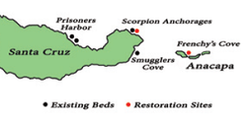Santa Cruz Island & Frenchy's Cove

[8]
Following an El Nino event (1982-83), all eelgrass meadows around Anacapa Island and one at Little Scorpion on Santa Cruz Island disappeared. They were mowed down by hungry sea urchins, whose populations exploded, then crashed. These meadows have never recovered.
A cooperative effort between Channelkeeper, the Channel Islands Research Program (CIRP), and NOAA Fisheries' Community-Based Restoration Program was undertaken to restore the sites [3].
The restoration program included the collection, culture, and transplanting of seeds and seedlings, in addition to the transport of established plants from donor locations.
This project is proving to be highly successful as beds continue to spread through vegetative growth and seed production. It is much easier to restore meadows that have been degraded from natural causes, such as this, compared to anthropogenic degradation; this is due to persistence of the conditions that caused the decline. Thus, in order to restore populations at locations in which physical conditions have changed, other approaches must be taken.
A cooperative effort between Channelkeeper, the Channel Islands Research Program (CIRP), and NOAA Fisheries' Community-Based Restoration Program was undertaken to restore the sites [3].
The restoration program included the collection, culture, and transplanting of seeds and seedlings, in addition to the transport of established plants from donor locations.
This project is proving to be highly successful as beds continue to spread through vegetative growth and seed production. It is much easier to restore meadows that have been degraded from natural causes, such as this, compared to anthropogenic degradation; this is due to persistence of the conditions that caused the decline. Thus, in order to restore populations at locations in which physical conditions have changed, other approaches must be taken.
